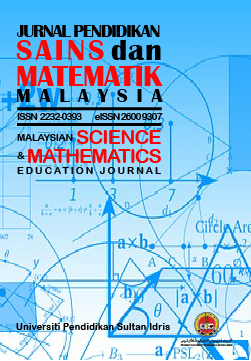Weaving Culture and Science: A reflection on teaching science through story-telling
DOI:
https://doi.org/10.37134/jpsmm.vol13.2.5.2023Keywords:
story-telling, culturally responsive education, culture, Hang Tuah, science educationAbstract
Implementing culturally responsive education is possible by incorporating story-telling into science teaching and learning. It can be viewed as one way to present new scientific concepts or information that may be complex or difficult to comprehend. This study uses a local Malay folklore story, 'Hang Tuah dan Keris Tamingsari', alongside a hands-on activity during an after-school holiday program for primary students in a local library. A total of 25 participants were involved and their written reflection was collected. The collected data and images were coded and analysed along with the participatory observation. The results indicate that while participants expressed fascination with the story and the handicraft activity, they struggled to recall the science concept. Many mentioned learning about Hang Tuah and its noble values, emphasizing their engagement with the story and the craft rather than the intended science learning. This suggests the need to improve the alignment between the story, hands-on activity, and the science concept conveyed in the story. However, this is not a conclusive study as the findings may be influenced by factors such as the age group, duration of the program, and the reliability of participants' reflections. Several recommendations are provided to enhance the delivery of science content through story-telling in future research.
Downloads
References
Amedu, O. I. (2015). The Effect of Gender on the Achievement of Students in Biology Using the Jigsaw Method. Journal of Education and Practice, 6(17), 176–179. https://doi.org/10.3389/fpsyg.2013.00442
Anisa, A. N., Syafrudin, U., & Drupadi, R. (2021). Playing Origami Dan Its Impact on Fine Motor Skills Development of Children Aged 4-5. Journal of Early Childhood Education (JECE), 3(1), 22–30. https://doi.org/10.15408/jece.v3i1.19059
Azmah, N., Yusuff, N., Abdullah, N., Tek, O. E., Pendidikan, U., Idris, S., & Selangor, H. (2016). The effectiveness of hands-on/authentic learning on elementary school students’ achievement in and attitudes towards science. Jurnal Pendidikan Sains & Matematik Malaysia, 6(1), 79–100.
Betsch, C., Ulshöfer, C., Renkewitz, F., & Betsch, T. (2011). The Influence of Narrative v. Statistical Information on Perceiving Vaccination Risks. Medical Decision Making, 31(5), 742–753. https://doi.org/10.1177/0272989X11400419
Boakes, N. J. (2009). Origami Instruction in the Middle School Mathematics Classroom: Its Impact on Spatial Visualization and Geometry Knowledge of Students. RMLE Online, 32(7), 1–12. https://doi.org/10.1080/19404476.2009.11462060
Crawford, B. A. (2014). From Inquiry to Scientific Practices in the Science Classroom. In S. K. Abell & N. G. Lederman (Eds.), Handbook of Research on Science Education. Mahwah, NJ: Lawrence Erlbaum Association, Inc.
Csikar, E., & Stefaniak, J. E. (2018). The utility of storytelling strategies in the biology classroom. Contemporary Educational Technology, 9(1), 42–60. https://doi.org/10.30935/cedtech/6210
Hadzigeorgiou, Y. (2016). Narrative Thinking and Storytelling in Science Education. In Imaginative Science Education: The Central Role of Imagination in Science Education (pp. 83–119). https://doi.org/10.1007/978-3-319-29526-8
Krupa, J. J. (2014). Scientific method & evolutionary theory elucidated by the Ivory-Billed Woodpecker story. American Biology Teacher, 76(3), 160–170.
Lencioni. (2004). Death by meeting: A leadership fable. San Francisco, CA, USA: Jossey-Bass.
Matamit, H. N. H., Roslan, R., Shahrill, M., & Said, H. M. (2020). Teaching challenges on the use of storytelling in elementary science lessons. International Journal of Evaluation and Research in Education, 9(3), 716–722. https://doi.org/10.11591/ijere.v9i3.20596
McDonald, J. K. (2009). Imaginative instruction: What master storytellers can teach instructional designers. Educational Media International, 46(2), 111–122. https://doi.org/10.1080/09523980902933318
Olson, R. (2015). Houston, we have a narrative: Why science needs story. Chicago, USA: The University of Chicago Press.
Ong, K. J., chou, Y.-C., & Yang, D.-Y. (2019). The impact of science fair on the students’ engagement, capacity, continuity, and motivation towards science learning. Jurnal Pendidikan Sains Dan Matematik Malaysia, 9(1), 1–12. https://doi.org/10.37134/jpsmm.vol9.1.1.2019
Supple, B., Neill, S., & Hao, G. (2021). Beyond Paper Folding : Origami and Focused Play to Enhance Interdisciplinary Learning and Teaching in Universities. Aishe-J, 13(November), 1–13.
Tan, M., Lee, S. S., & Hung, D. W. (2014). Digital storytelling and the nature of knowledge. Education and Information Technologies, 19(3), 623–635.
Walan, S. (2019). Teaching children science through storytelling combined with hands-on activities–a successful instructional strategy? Education 3-13, 47(1), 34–46. https://doi.org/10.1080/03004279.2017.1386228
Wallace, J., Howes, E. V., Funk, A., Krepski, S., Pincus, M., Sylvester, S., … Swift, S. (2022). Stories That Teachers Tell: Exploring Culturally Responsive Science Teaching. Education Sciences, 12(6). https://doi.org/10.3390/educsci12060401
Yin, C. W., Tek, O. E., & Salleh, S. M. (2016). The use of jigsaw in primary science: what do year 5 children say on its influence on their attitudes towards science. Jurnal Pendidikan Sains & Matematik Malaysia, 6(2), 32–43.
Downloads
Published
Issue
Section
License
Copyright (c) 2023 Loh Su Ling, Zainun Mustafa, Nur Ezdiani Yusoff

This work is licensed under a Creative Commons Attribution-NonCommercial-ShareAlike 4.0 International License.





